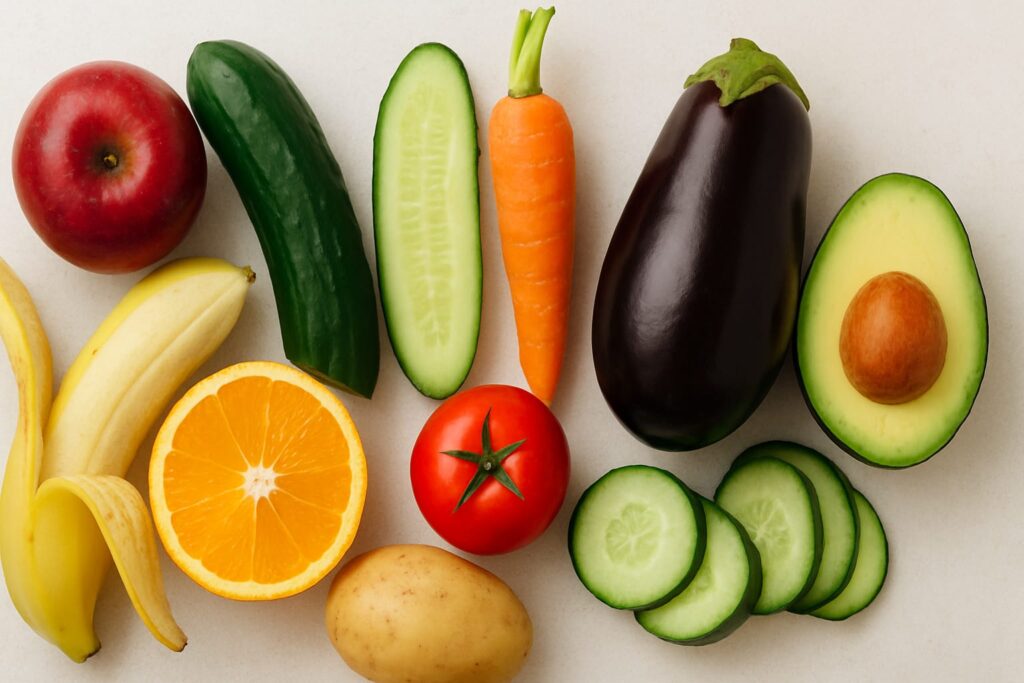Fruits and Vegetables With or Without Skin: Smart Choices
When it comes to fruits and vegetables with or without skin, many people wonder which option is healthier. Should you peel your apples, potatoes, or cucumbers, or leave the skins on? The answer depends on nutrition, safety, taste, and personal preference. In this detailed guide, we’ll explore the benefits and drawbacks of eating produce with or without skin, when to peel, and how to get the most from your fruits and vegetables.

Why Choosing Fruits and Vegetables With or Without Skin Matters
The choice of fruits and vegetables with or without skin has a major impact on both nutrition and food waste. Skins often contain essential nutrients such as vitamins, minerals, fibre, and antioxidants. By contrast, peeling removes not only the outer layer but also a large portion of these beneficial compounds.
Moreover, eating fruits and vegetables with their skins supports sustainability. It reduces food waste and maximises the nutrients you get from every bite. However, not all skins are pleasant or even safe to eat, so it’s crucial to know when to keep them and when to peel.
Nutritional Benefits of Fruits and Vegetables With Skin
Skins Are Packed With Vitamins and Fibre
One of the strongest reasons to eat fruits and vegetables with skin is their impressive nutrient content. For instance, a raw apple with its peel can contain more than twice the vitamin C and fibre of a peeled apple. The skin also provides vitamin K, folate, potassium, and a range of antioxidants that protect your cells from damage.
Similarly, vegetables like carrots, cucumbers, and potatoes hold much of their fibre and phytonutrients close to or within the skin. By keeping the peel, you preserve nutrients that would otherwise be lost during preparation.
Fibre Supports Gut Health and Satiety
Another major benefit of consuming fruits and vegetables with or without skin, particularly with skin, is fibre. Dietary fibre helps regulate digestion, promotes healthy gut bacteria, and keeps you feeling full longer. This can assist with weight management and reduce the risk of digestive issues such as constipation.
Additionally, fibre in the skin slows sugar absorption, helping to stabilise blood glucose levels. Therefore, eating fruits and vegetables with skin contributes to both gut and metabolic health.
Skins Contain Powerful Antioxidants
Many colourful peels, like those on apples, grapes, eggplants, or bell peppers, contain antioxidants such as quercetin, anthocyanins, and carotenoids. These compounds fight oxidative stress and inflammation, both linked to ageing and chronic diseases.
For example, grape and apple skins contain resveratrol and quercetin, while potato skins are rich in polyphenols. Hence, when you eat produce with skin, you’re consuming more of these beneficial phytochemicals.
When to Choose Fruits and Vegetables Without Skin
Digestive Sensitivity and Texture
Although skins are nutritious, they can sometimes be difficult to digest, particularly for people with sensitive stomachs or digestive disorders. Thick, fibrous skins such as those on eggplants or squash may cause discomfort for some individuals. In those cases, peeling may make vegetables easier to digest and smoother in texture.
Food Safety and Pesticide Residues
Another concern is pesticide residue. Conventionally grown produce can retain chemical traces on its skin. While washing helps, peeling can further reduce exposure. If you’re unsure about pesticide levels, choose organic produce when possible or peel fruits and vegetables that are heavily treated, such as apples, peaches, or cucumbers.
That said, washing under running water and using a vegetable brush often removes most residues effectively. Thus, you can safely eat many fruits and vegetables with their skins if cleaned properly.
Taste and Appearance
Taste also plays a role. Some skins are bitter, tough, or waxy. For example, citrus peels, avocado skins, and pineapple rinds are inedible or unappealing. On the other hand, soft, thin peels like those of apples, pears, and carrots add a pleasant texture.
Ultimately, whether you choose fruits and vegetables with or without skin depends on your taste preference and the recipe you’re preparing.
Examples: Fruits and Vegetables With or Without Skin
Apples
Apple skins are full of antioxidants, fibre, and vitamin C. Leaving them on not only boosts nutrition but also adds flavour and texture. Unless you’re baking a smooth dessert or sauce, it’s generally better to keep the peel.
Potatoes
Potato skins provide potassium, magnesium, and vitamin C. Baked or roasted potatoes taste great with skin on, but if the skin is green or wrinkled, peel it before cooking.
Carrots
Carrot skins contain essential nutrients, so washing rather than peeling is usually best. The thin skin softens during cooking and adds colour and fibre.
Cucumbers
Cucumber skins are rich in vitamin K and antioxidants. However, if the peel is waxed or thick, peeling may improve texture and digestibility.
Citrus Fruits
While citrus rinds aren’t eaten whole, zesting the outer peel adds vitamin C and flavour. The white pith underneath, though slightly bitter, is also full of fibre.
Eggplants
Eggplant skins contain nasunin, an antioxidant that protects brain cells. Smaller or younger eggplants have tender skins, but larger ones may need peeling to avoid a leathery texture.
How to Clean and Prepare Fruits and Vegetables With Skin
To enjoy the benefits of fruits and vegetables with skin safely, proper cleaning is essential. Here’s how to do it right:
- Wash under running water, don’t soak, as soaking can spread contaminants.
- Use a vegetable brush for firm produce such as potatoes or carrots.
- Avoid soap or detergent, these are not food-safe.
- Dry with a clean towel to remove any remaining dirt or bacteria.
- Trim damaged areas or bruises before eating or cooking.
By following these simple steps, you can confidently eat most fruits and vegetables with skin and enjoy their full nutritional potential.
Cooking Tips for Fruits and Vegetables With or Without Skin
When Cooking With Skin
Cooking fruits and vegetables with skin can preserve nutrients and enhance flavour. For instance, roasting potatoes or baking apples with skin helps retain moisture and prevents nutrient loss.
Moreover, heat often softens skins, making them easier to digest. This means even people with mild sensitivities can tolerate cooked skins better than raw ones.
When Cooking Without Skin
In contrast, some recipes, like purees, sauces, or baby food, benefit from peeled produce for a smoother texture. When peeling, try to remove only the thinnest possible layer to minimise nutrient loss. You can also repurpose the discarded peels in creative ways.
Reusing Skins to Reduce Waste
Instead of throwing peels away, you can use them to make vegetable stock, baked crisps, or compost. Dried fruit peels, such as those from apples or citrus, can even be used to flavour teas or desserts. This way, you not only cut waste but also get extra nutrition.
Fruits and Vegetables With or Without Skin for Specific Needs
For Weight Management
Eating fruits and vegetables with their skins helps you feel full for longer, reducing the temptation to snack between meals. The fibre content slows digestion and keeps blood sugar levels stable.
For Digestive Health
Fibre from skins feeds beneficial gut bacteria, which improve digestion and immune function. However, if you suffer from conditions like IBS, choose peeled or cooked produce for easier digestion.
For Children and the Elderly
For kids or older adults, peeling may make fruits and vegetables easier to chew. Still, introducing thin edible skins gradually can help develop healthier habits over time.
Best Practices: Deciding Between Fruits and Vegetables With or Without Skin
Here’s a quick reference table for your kitchen:
|
Produce Type |
Best Choice |
Reason |
|
Apple |
With skin |
High fibre and antioxidants |
|
Potato |
With skin |
Extra potassium, vitamin C |
|
Carrot |
With skin |
Contains valuable nutrients |
|
Cucumber |
With or without |
Peel if waxed |
|
Eggplant |
With or without |
Peel large ones |
|
Citrus |
Without (use zest) |
Rind inedible raw |
|
Zucchini |
With skin |
Thin, tender peel |
|
Kiwi |
With or without |
Skin edible but fuzzy |
|
Mango |
Without |
Tough peel |
Sustainability Aspect of Fruits and Vegetables With or Without Skin
Beyond nutrition, your choice also affects the environment. Every time you peel, you discard edible material that took water and energy to grow. Choosing fruits and vegetables with skin reduces waste and lowers your ecological footprint.
Moreover, using peels creatively: for teas, chips, or compost, ensures that even when you do peel, nothing goes to waste. Small daily choices like this contribute to more sustainable food habits.
Common Myths About Fruits and Vegetables With or Without Skin
- Myth: Skins are full of harmful chemicals.
Truth: Proper washing removes most residues; organic options minimise risks further. - Myth: Skins have no nutritional value.
Truth: Most antioxidants and fibre are concentrated in the peel. - Myth: Peeling always makes food safer.
Truth: Peeling helps for certain produce but also removes protective nutrients. - Myth: Cooked skins lose all nutrients.
Truth: Some nutrients degrade with heat, but many remain intact or even become more bioavailable.
Final Thoughts on Fruits and Vegetables With or Without Skin
To conclude, the decision to eat fruits and vegetables with or without skin is not absolute. In general, keeping the skin on offers greater nutrition, flavour, and sustainability. Nevertheless, factors such as safety, texture, and digestion also matter.
Whenever possible, eat produce with edible, clean, and thin skins. like apples, carrots, potatoes, and cucumbers. For tougher or inedible peels, peel lightly and reuse the skin creatively.
By balancing nutrition, safety, and personal comfort, you can make smart choices that nourish both your body and the planet.
